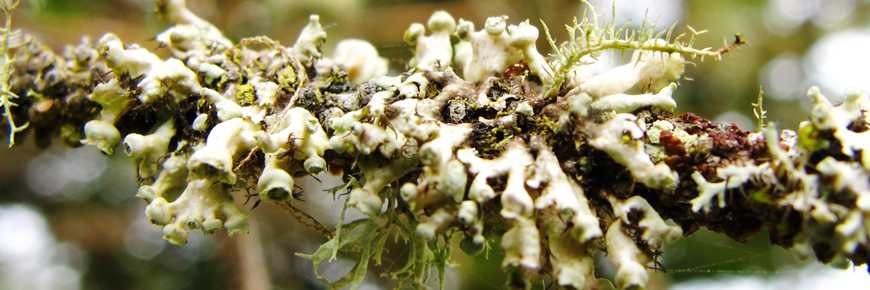
Seaside Centipede Lichen (Heterodermia sitchensis): Species at Risk recovery
Pacific Rim National Park Reserve
uʔup (moss or lichen)
Lichens are actually two separate organisms, a fungus and an alga, that have a symbiotic relationship. The Seaside Centipede Lichen is pale-green in colour with tiny blueberry or urn-shaped reproductive structures that grow from the upper surface of the body (thalli) of the lichen and grow no bigger than the tip of a sharp pencil (1-2mm). They are tiny! The entire thalli is the size of a pencil eraser. They only grow on the lower branches of old growth Sitka Spruce, in very few places on Vancouver Island’s west coast.
Three Reasons to love the Seaside Centipede Lichen
1. They only grow in very specific places

The Seaside Centipede Lichen needs such specific conditions to thrive that it has probably always been uncommon. For that reason, we need to do all we can to protect the type of habitat it depends on. This small lichen needs the small tips of lower branches of old growth Sitka Spruce trees in protected outer coast areas that are within a few meters of the high tide line. They also need an added marine nutrient source found in droppings from seabird colonies, sea lion haul outs and Indigenous middens (piles of shells and bones).
2. The closer you look, the more you may find

This species was first discovered in Pacific Rim National Park Reserve in the mid-1980s and was only found in two places. After more extensive surveys in the early 2000s the species range was extended to two additional sites: one 130 km north on central Vancouver Island, and the other in the state of Oregon to the south. Currently, there are 12 known sites on Vancouver Island’s west coast, however nearly 90 percent of the known lichen are concentrated at only five of these locations, the majority of which are within the national park reserve.
3. Distinctly west coast species.

The Seaside Centipede Lichen is a fascinating example of the inter-connectedness of many land and sea creatures. Not only is it important to protect the trees and branches upon which it grows, but also sea birds or sea lions that provide them with essential nutrients. Although these species are at serious risk, we are lucky that many are protected in Canada.
Three ways to care for the Seaside Centipede Lichen
1. Protect critical habitat.

Parks Canada and Pacific Rim National Park Reserve protect five of the 12 known locations of Seaside Centipede Lichen in Canada. In these locations they are protected from logging, coastal development, tree pruning and vegetation removal.
Parks Canada’s action:
The Canada National Parks Act protects this species from human disturbance and Parks Canada actively educates visitors about the importance of the species and enforces the rules and regulations that protect the species.Action you can take:
National park reserve visitors are asked to respect closures and to leave all vegetation as they find it. This means staying out of closed areas, not cutting or breaking branches and not collecting tree branches to use as firewood.
2. Increase awareness of this species.

With small, short-lived and out of sight species, like the Seaside Centipede Lichen, the more awareness of their existence the better. Learning more and understanding the connections between species and nutrient transport between land and sea is important.
Parks Canada’s action:
Parks Canada led the development of the Recovery Strategy for Seaside Centipede Lichen, under the Species at Risk Act. This strategy highlighted the need to maintain the current population, understand critical habitat requirements, as well as increase research and public education.
Action you can take:
Do your part to ensure healthy ecosystems remain for generations to come. Respect Rockfish Conservation Areas and federal Marine Mammal Regulations. The effects of fishing and disturbance on marine mammals and seabirds has far wider impacts than you might imagine.
3. Ongoing monitoring of known sites.

The saying “the more eyes the better” is certainly true for this species. Until more extensive studies were conducted by Parks Canada in 2001, the Seaside Centipede Lichen was only known to be present in two locations.
Parks Canada’s action:
Parks Canada scientists conduct ongoing monitoring of the known sites within Pacific Rim National Park Reserve.Action you can take:
Learn more about rare species at risk in your area. If you think you’ve found a rare species, make sure to not disturb it and contact the BC Conservation Data Center.For more information view the Seaside Centipede Lichen on the Species at Risk Registry
- Date modified :